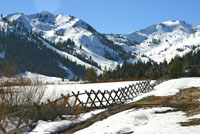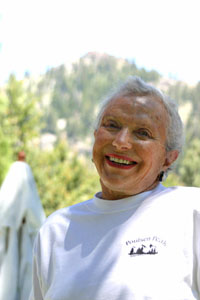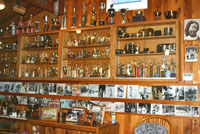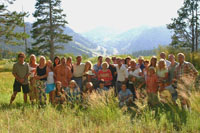 |
|
|
Follow Mark on Facebook for more stories |
||
|
Sandy Poulsen: "First Lady of Squaw Valley"
In some ways, Sandy Poulsen was an unlikely pioneer. She was born in Buffalo, New York, on August 3, 1918, to Oscar and Gladys Kunau. Sandy was raised as a debutante in a world of comfort and privilege. Her father had achieved financial success in the textile industry and the family lived in a penthouse at the luxurious Sherry-Netherland Hotel, which overlooked Central Park in mid-town Manhattan. After high school Sandy entered Smith College, a private women's liberal arts college in Northampton, Massachusetts. She enjoyed her classes and weekend ski trips in New England. Among her best friends was Kathleen Harriman, the daughter of Union Pacific Railroad tycoon Averell Harriman. During the 1930s, Harriman noted that more Americans were becoming interested in winter sports. As Chairman of Union Pacific , Harriman realized his railroad traversed some of the most scenic and mountainous areas in the West, and in 1935 he hired an agent to search out a good location for an upscale winter resort that could be accessed by UP trains. The best spot turned out to be near Ketchum, Idaho, and on December 21,1936, Sun Valley Resort, the West's first destination ski area, opened to international publicity. In 1941, Kathleen Harriman suggested that Sandy take a ski trip to Sun Valley on her father's railroad line. The idea intrigued Sandy who was tired of the hard, icy snow conditions on the slopes in New England. Kathleen told her that the snow at Sun Valley was deep and soft. Sandy had recently seen the romantic movie, "Sun Valley Serenade" starring Sonja Henie, a world-class ice skater and Olympic champion. The stunning alpine scenery drew Sandy like a powerful magnet, so she packed her things and bought a train ticket for a trip to Idaho. It took her five days to reach Salt Lake City and then another day or two to reach Sun Valley where she boldly checked into the ski lodge unescorted.
Their glamorous wedding was held in August 1942 at the beautiful Santa Monica oceanfront home of the famous Hollywood actress Norma Shearer. Shearer's first husband had died tragically in 1936, but in an interesting twist of fate, she too had decided to take a ski vacation at Sun Valley during the same winter as Sandy Kunau. While there, she met and fell in love with Martin Arrougé, a San Francisco-born ski instructor fifteen years her junior. "Marti" Arrougé also happened to be one of Wayne Poulsen's best ski buddies from the early days in Nevada. Later the young men had both become ski instructors at Sun Valley. The romantic magic of Sun Valley depicted in the movie must have been true; at the resort both Poulsen and Arrougé met their future brides and lifelong partners. Marti Arrougé's father was a Basque sheepherder who tended the flocks that grazed in the meadows of Squaw Valley during the mild summer months. When Wayne and Marti were in high school, it was Marti's father who invited the two teenagers up to fish and hike in the nearby mountains. During that summer sojourn, Poulsen fell in love with Squaw Valley and began to dream that he could develop it into a wonderful ski area. At the time Wayne told Sandy about living in Squaw Valley he didn't own anything there, but true to his word, in 1943 he purchased 640 acres from Southern Pacific Railroad. Wayne whisked Sandy away from her upscale lifestyle in Manhattan and moved her into a tent in remote Squaw Valley. They spent the summer in the valley, bathing in the frigid waters of Shirley Canyon and eating the fresh trout Wayne caught everyday. It was tough going in the early days, but Sandy had no complaints. She often recalled how peaceful the valley was and that although the couple had virtually nothing in the way of material possessions, they were full of hopes and dreams. After World War II ended, the Poulsen's purchased two surplus army barracks and converted them into a real home that could withstand the severe Sierra winters. It was the first house built in Squaw Valley and survives today as Graham's Restaurant.
While skiing at Alta, Utah, in 1946, the couple met Alex Cushing, a Harvard -educated lawyer with financial contacts. The Poulsen's needed investors for their dream of making Squaw Valley into a ski area and in 1948 Cushing became their partner in the Squaw Valley Development Corporation. The business relationship did not work out, however, and Cushing went on to develop the valley as a ski resort while the Poulsen's began a successful career in real estate selling the land they owned there. Sandy Poulsen always had a sense of adventure. She was one of the first women to earn a commercial pilot's license and after World War II the Poulsen's purchased a single-engine plane. The war surplus, two-man aircraft had an open cockpit; Sandy and Wayne wore leather helmets and communicated using a rubber tube. After they bought an amphibious floatplane, they took family camping trips to Alaska or fishing trips to remote Sierra lakes. In later years, they sometimes used the floatplane to visit Tahoe lakefront restaurants for dinner. One of the classic stories about Sandy involves her "improving" skiing ability. During the design stage of the ski resort in 1948, Sandy and Wayne were skiing a very steep, north-facing slope. Wayne was an expert skier and proved it by carving turns straight down the steep pitch. Sandy, however, was terrified and could only negotiate the slope by traversing into the trees to secretly make a kick turn. (Wayne had told her he wanted her to "ski" down the mountain, not traverse the slope with kick turns.) Despite Wayne's admonishments to ski, Sandy continued to kick turn and traverse the slope little by little until she reached the bottom. Wayne, who was patiently waiting and counting the number of traverses, calmly informed her that she had made 22 kick turns to negotiate the hill. He then named the mountain KT-22 in honor of her embarrassing descent. KT-22 remains one of America's favorite and challenging ski slopes.
Sandy's love for Squaw Valley was only surpassed by her love for her husband and her family who survive her including her eight children: Christian, Wayne Jr., Lance, Eric, Sandra, Craig, Glen and Russell, as well as her 18 grandchildren and one great grandchild. Sandy Poulsen was a true pioneer, a loving mother, an inspiration and pillar of strength to those who knew her and a great lover of life. Sandy Poulsen regularly attended the Squaw Valley Chapel, which was built for the 1960 Winter Olympics after the Poulsen's donated the land that the church now sits on. The charming chapel is a fitting tribute to Wayne and Sandy, located between KT -22 and Poulsen Peak. In 1992, Sandy Poulsen said, "I grew up in New York, in a penthouse, but I ended up living in a tent in Squaw Valley. Yet I couldn't have been luckier." Rest in peace Sandy. |
|||||||||||||||||||||||
|




